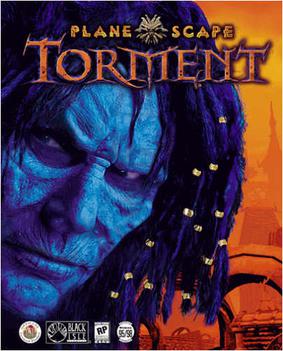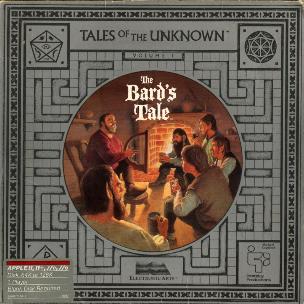Bethesda Softworks LLC is an American video game publisher based in Rockville, Maryland. The company was founded by Christopher Weaver in 1986 as a division of Media Technology Limited. In 1999, it became a subsidiary of ZeniMax Media. In its first 15 years, it was a video game developer and self-published its titles. In 2001, Bethesda spun off its in-house development team into Bethesda Game Studios, leaving Bethesda Softworks to focus on publishing operations.

Planescape: Torment is a 1999 role-playing video game developed by Black Isle Studios and published by Interplay Entertainment for Windows. The game takes place in locations from the multiverse of Planescape, a Dungeons & Dragons (D&D) fantasy campaign setting. The game's engine is a modified version of the Infinity Engine, which was used for BioWare's Baldur's Gate, a previous D&D game set in the Forgotten Realms.

Fallout is a media franchise of post-apocalyptic role-playing video games—and later action role-playing games—created by Tim Cain and Leonard Boyarsky, at Interplay Entertainment. The series is set during the 21st, 22nd, and 23rd centuries, and its atomicpunk retrofuturistic setting and art work are influenced by the post-war culture of 1950s United States, with its combination of hope for the promises of technology and the lurking fear of nuclear annihilation. A forerunner of Fallout is Wasteland, a 1988 game developed by Interplay Productions which is regarded as a spiritual successor to the series.

The Bard's Tale is a fantasy role-playing video game designed and programmed by Michael Cranford for the Apple II. It was produced by Interplay Productions in 1985 and distributed by Electronic Arts. The game was ported to the Commodore 64, Apple IIGS, ZX Spectrum, Amstrad CPC, Amiga, Atari ST, DOS, Macintosh, and NES. It spawned The Bard's Tale series of games and books. The earliest editions of the game used a series title of Tales of the Unknown, but this title was dropped for later ports of The Bard's Tale and subsequent games in the series.

Interplay Entertainment Corp. is an American video game developer and publisher based in Los Angeles. The company was founded in 1983 as Interplay Productions by developers Brian Fargo, Jay Patel, Troy Worrell, and Rebecca Heineman, as well as investor Chris Wells. As a developer, Interplay is best known as the creator of the Fallout series and as a publisher for the Baldur's Gate and Descent series.

Frank Brian Fargo is an American video game designer, producer, programmer and executive, and founder of Interplay Entertainment, inXile Entertainment and Robot Cache.

Fallout 2: A Post Nuclear Role Playing Game is a 1998 role-playing video game developed by Black Isle Studios and published by Interplay Productions. It is a sequel to Fallout (1997), featuring similar graphics and game mechanics. The game's story takes place in 2241, 80 years after the events of Fallout and 164 years after the atomic war which reduced the vast majority of the world to a nuclear wasteland. The player assumes the role of The Chosen One, the grandchild of the first game's protagonist, and undertakes a quest to save their small village on the West Coast of the United States.
Obsidian Entertainment, Inc. is an American video game developer based in Irvine, California. It was founded in June 2003, shortly before the closure of Black Isle Studios, by ex-Black Isle employees Feargus Urquhart, Chris Avellone, Chris Parker, Darren Monahan, and Chris Jones.

inXile Entertainment, Inc. is an American video game developer and a studio of Xbox Game Studios based in Tustin, California. Specializing in role-playing video games, inXile was founded in 2002 by Interplay co-founder Brian Fargo. The studio produced the fantasy games The Bard's Tale and Hunted: The Demon's Forge, along with various games for Flash and iOS such as Fantastic Contraption in its first decade of development. In 2014, inXile released the post-apocalyptic game Wasteland 2, following a successful Kickstarter campaign. Following the game's critical success, the studio went on to raise a then-record US$4 million on Kickstarter to develop Torment: Tides of Numenera, a spiritual successor to Interplay's Planescape: Torment. The studio was purchased by Microsoft and became part of Xbox Game Studios in 2018, just as they were developing Wasteland 3, which they released in 2020. The studio is currently developing Clockwork Revolution for Windows and Xbox Series X/S.

Fallout: A Post Nuclear Role Playing Game is a 1997 role-playing video game developed and published by Interplay Productions. Set in a mid-22nd century post-apocalyptic and retro-futuristic world, decades after a nuclear war between the United States and China. Fallout's protagonist, the Vault Dweller, inhabits an underground nuclear shelter. The player must scour the surrounding wasteland for a computer chip that can fix the Vault's failed water supply system. They interact with other survivors, some of whom give them missions, and engage in turn-based combat.

Fallout 3 is a 2008 action role-playing game developed by Bethesda Game Studios and published by Bethesda Softworks. The third major installment in the Fallout series, it is the first game to be developed by Bethesda after acquiring the rights to the franchise from Interplay Entertainment. The game marks a major shift in the series by using 3D graphics and real-time combat, replacing the 2D isometric graphics and turn-based combat of previous installments. It was released worldwide in October 2008 for Microsoft Windows, PlayStation 3, and Xbox 360.

Jason D. Anderson, usually credited as Jason Anderson, is a video game developer. He started out as a contract artist for Interplay on the USCF Chess project. He was later hired to work on Fallout for which he became Lead Technical Artist, working on the original game design, interface, and quests. After working on the prototype design for Fallout 2, Anderson left with fellow developers Timothy Cain and Leonard Boyarsky to found Troika Games. After Troika Games collapsed, Anderson left the game industry for a short time to sell real estate.
Meantime was a cancelled role-playing video game originally intended for the Apple II and possibly for the Commodore 64. It was a follow-up to 1988's Wasteland, produced by Interplay, using the same engine as Wasteland. Brian Fargo halted development for this platform, in part due to the falling 8-bit computer market. Later attempts were made to finish the game for MS-DOS, but the project was canceled for good after the release of the competing Ultima VII, as it was felt they would be releasing a graphically inferior product.

Fallout: New Vegas is a 2010 action role-playing game developed by Obsidian Entertainment and published by Bethesda Softworks. It was announced in April 2009 and released for PlayStation 3, Windows, and Xbox 360 on October 19, 2010. A spin-off of the main Fallout series, the game is set in a post-apocalyptic open-world environment that encompasses a region consisting of parts of Arizona, California, and Nevada. It is set in a world that deviated onto an alternate timeline thanks to Atomic Age technology, which eventually led to a global nuclear apocalypse in the year 2077 in an event referred to as "The Great War", caused by a major conflict between the U.S. and China over natural resources. The main story of New Vegas takes place in the year 2281, four years after the events of Fallout 3 and 204 years after the bombs fell. It is not a sequel but does feature the return of several elements found in Fallout 2.
Western role-playing video games are role-playing video games developed in the Western world, including The Americas and Europe. They originated on mainframe university computer systems in the 1970s, were later popularized by titles such as Ultima and Wizardry in the early- to mid-1980s, and continue to be produced for modern home computer and video game console systems. The genre's "Golden Age" occurred in the mid- to late-1980s, and its popularity suffered a downturn in the mid-1990s as developers struggled to keep up with changing fashion, hardware evolution and increasing development costs. A later series of isometric role-playing games, published by Interplay Productions and Blizzard Entertainment, was developed over a longer time period and set new standards of production quality.

Wasteland 2 is a post-apocalyptic role-playing video game developed by inXile Entertainment and published by Deep Silver. It is the sequel to 1988's Wasteland, and was successfully crowdfunded through Kickstarter. After the postponement of the original release date from October 2013, it was released for Microsoft Windows, OS X, and Linux in September 2014. An enhanced version of the game, named Wasteland 2: Director's Cut, was released in October 2015, including versions for PlayStation 4, Xbox One, and Nintendo Switch.

Torment: Tides of Numenera is a role-playing video game developed by inXile Entertainment and published by Techland Publishing for Microsoft Windows, macOS, Linux, PlayStation 4 and Xbox One. It is a spiritual successor to 1999's Planescape: Torment.

Wasteland 3 is a role-playing video game developed by inXile Entertainment and published by Deep Silver. It is a sequel to Wasteland 2 (2014) and was released for Microsoft Windows, PlayStation 4 and Xbox One on August 28, 2020. It was ported to Linux and macOS on December 17, 2020.
Wasteland is a role-playing video game series created by Brian Fargo. The first game, Wasteland, was originally developed by Interplay Productions and published by Electronic Arts in 1988. inXile Entertainment later acquired the intellectual property from Electronic Arts and developed two sequels, Wasteland 2 (2014) and Wasteland 3 (2020), based on crowdfunding and published by Deep Silver. The games are set in post-apocalyptic open worlds and features turn-based combat similar to that of the earlier Fallout games, of which they are a spiritual predecessor. Xbox Game Studios owns the series after their acquisition of inXile Entertainment.

















